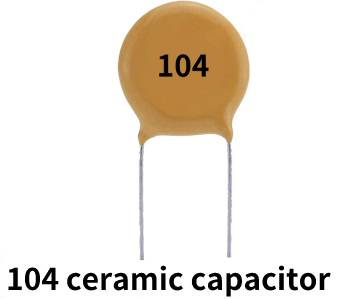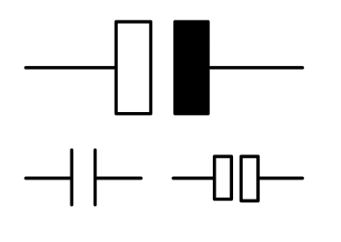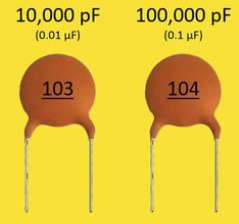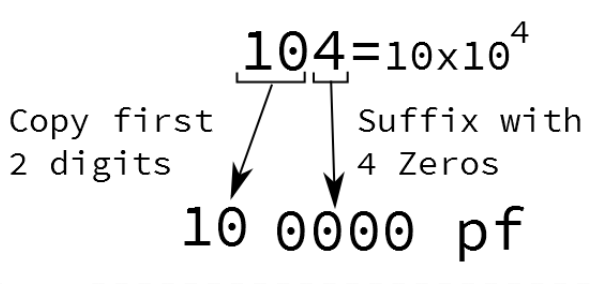What Value Is a 104 Capacitor?
The 104 capacitor has a capacitance value of 100,000 picofarads (pF), which translates to 0.1 microfarads (µF). The value is derived from the number “104” printed on its body. This numbering follows a standard coding system for capacitors, where the first two digits represent the significant numbers (10), and the third digit (4) acts as the multiplier, adding four zeros to the base value. Therefore, the final capacitance is 10×10^4pF.

The 0.1 µF value places the 104 capacitor in the mid-range of capacitance values. It is suitable for many tasks, such as bypassing unwanted signals, stabilizing power supplies, and coupling circuits. That is why it can handle both low and high-frequency signals effectively.
Do 104 Capacitors Have Polarity?
The 104 capacitor is typically a ceramic capacitor, which is a non-polarized component. This means it does not have positive or negative terminals and can be installed in either orientation in a circuit. Below is 104 capacitor symbol:

Non-polarity feature of 104 capacitor offers several advantages:
- Easy to installation: It is much easy to install even if you are not familiar with capacitor. You don’t need to worry about aligning the capacitor in a specific direction during assembly.
- Universality: It is suitable for various circuit configurations because it can handle both AC and DC signals.
- High reliability: Non-polarized capacitors generally have fewer limitations in terms of operating conditions, such as reversing polarity.
However, if the capacitor is part of a circuit with high voltages or specific requirements, it is crucial to ensure it meets the circuit’s demands to avoid failure. Consult your manufacturer or technical engineer is a good method.
What Is the Voltage Rating of a 104 Capacitor?
The voltage rating indicates the maximum voltage of the capacitor that it can safely handle without breaking down. The voltage rating of 104 capacitor varies depending on the specific type/PN and manufacturer. Common voltage ratings for 104 capacitors include 16V, 25V, 50V, 100V, and even higher.
When selecting a 104 capacitor for your circuit, always choose one with a voltage rating that exceeds the highest voltage present in the circuit. For instance, if your circuit operates at 12V, a capacitor with a 16V or 25V rating is enough. However, using a capacitor with a higher rating, such as 50V, adds an extra layer of safety.
Exceeding the voltage rating can lead to capacitor failure, resulting in circuit damage or unexpected behavior. Manufacturers often provide detailed datasheets specifying voltage ratings and other parameters, which can guide your selection.
What Is the Difference Between 103 and 104 Capacitors?
While both 103 and 104 capacitors are ceramic capacitors with similar physical appearances, they differ significantly in their capacitance values.
- A 103 capacitor has a capacitance value of 10,000 pF (or 0.01 µF).
- A 104 capacitor has a capacitance value of 100,000 pF (or 0.1 µF).

The choice between these two depends on the circuit’s requirements. For example:
A 103 capacitor is preferred in circuits that require lower capacitance, such as fine-tuned filters or high-frequency oscillators. A 104 capacitor is better suited for decoupling and filtering applications where a higher capacitance is needed to stabilize the power supply or smooth out signals.
How Do You Use a 104 Capacitor?
Using a 104 capacitor involves understanding its role in the circuit firstly and placing it correctly. Here are some practical examples:
- In Power Supplies: Place the capacitor across the power and ground lines near ICs to reduce noise and stabilize voltage.
- In Signal Coupling: Insert it between circuit stages to transfer AC signals while blocking DC components.
- In Oscillators or Timers: Pair it with resistors to create time constants that determine oscillation frequencies or delays.
- As a Filter: Use it in parallel with the load to suppress voltage spikes and smooth out the signal.
Warm Notice:
Ensure that the voltage rating of the capacitor matches or exceeds the circuit’s requirements. Proper placement and adherence to specifications guarantee optimal performance.
What Is the Use of a 104 Capacitor?
The 104 capacitor is widely used in various electronic circuits due to its broad applicability. Some of its most common uses include:
- Decoupling: It reduces electrical noise by filtering out high-frequency signals on power supply lines.
- Bypassing: In bypassing applications, the capacitor helps pass high-frequency signals while blocking DC.
- Coupling: It transfers AC signals between different stages of a circuit while isolating DC.
- Timing Circuits: Paired with resistors, the 104 capacitor helps set time delays or oscillation frequencies. This is commonly seen in pulse generation or timer ICs like the 555 timer.
- Filtering: In both analog and digital systems, it acts as a filter to smooth out voltage spikes or suppress unwanted signals.
How Do You Read a Capacitor Marked 104?
Reading a capacitor marked “104” is straightforward, thanks to the standardized marking system. You can follow below steps:
- Identify the First Two Digits: These represent the base value, which is 10 in this case.
- Read the Third Digit: This is the multiplier, indicating the number of zeros to add to the base value. For “104,” the multiplier is 4, meaning you add four zeros to 10.
- Calculate the Capacitance: The result is 10×10^4pF, which equals 100,000 pF or 0.1 µF.

What Is a Bad Capacitor Reading?
A bad capacitor reading occurs when its actual performance deviates from its labeled specifications. Common indicators of a bad capacitor include:
- Open Circuit: The capacitor shows no capacitance when tested.
- Short Circuit: The capacitor allows current to flow freely, indicating internal damage.
- Incorrect Capacitance: The measured value differs significantly from the labeled capacitance.
- Testing capacitors with a multimeter or capacitance meter can help confirm their condition. Physical signs like bulging, cracking, or leakage also indicate a faulty capacitor.
Regular testing and inspection ensure reliable circuit performance and prevent potential failures.
What Is the Equivalent of a 104 Capacitor?
The equivalent of a 104 capacitor depends on the required capacitance and voltage rating in the circuit. Any capacitor with a value of 0.1 µF and an appropriate voltage rating can replace a 104 capacitor. Alternatives include:
- Film Capacitors: Suitable for circuits requiring high precision and stability.
- Electrolytic Capacitors: Used in circuits with space constraints or specific requirements.
When substituting, ensure that the replacement capacitor meets or exceeds the original’s voltage rating to maintain reliability.
If you’re looking for high-quality capacitors for your projects, EBest Circuit (Best Technology) provides a wide range of electronic components sourcing. Partner with us to access top-notch solutions tailored to your needs, backed by excellent customer support and technical expertise. Reach out today to learn more!


